Winners Announcement of Optolong 2024 Nightscape Competition-Starryscape Dream
Winners Announcement of Optolong 2024 Nightscape Competition-Starryscape Dream
Until now, Optolong 2024 Nightscape Competition-Starryscape Dream has been done, we have a result from the judges.
We are so impressed by the creativity and talent of all the participants who submitted their entries. In the manwhile, massive thanks to our judges, Kerry-Ann Lecky Hepburn from Canada, Mehmet Ergün from Germany, Yuri Beletsky from Chile, Vincent Cheng from Hong Kong(China) and Steed(虞骏) from China to keep the contest equitable and fairness.
Now is the most exciting moment, the recipients of the prizes will be published here. Nine winners were born from both Nightscape Category and Special Celestial Phenomena Category. Congratulations!
►Winners of the Nightscape Category will be announced.
|
NightScape Categories |
Winners Number | Prizes |
| The 1st Prize | One winner to be selected |
1>Cash prize of US$2,000 *1 2>Optolong Nikon Z series clip-in filter *1 3>Award certificate *1 |
| The 2nd Prize | Two winners to be selected |
1>Cash prize of US$600 *1 2>Optolong Nikon Z series clip-in filter *1 3>Award certificate *1 |
| The 3rd Prize | Three winners to be selected |
1>Cash prize of US$300 *1 2>Optolong Nikon Z series clip-in filter *1 3>Award certificate *1 |
The First-Prize ONE Winner
♦1/1 Photo Number:356 Gods of Nemrut–Milkyway
Photographer: Cem Özkeser
Country: Turkey
Title of your Astrophoto, and imaging target: Gods of Nemrut–Milkyway
Equipment used and Description: Sony A7ii + Samyang 24mm f1.8 + Diffuser filter + Tripod –5x8sec f2.2 ISO3200 sky + 45sec f2 ISO3200 foreground –17-Dec-2022 –Nemrut Mountain, Adıyaman, Turkey
A 360-degree panoramic nightscene from a UNESCO World Heritage Site. You see the nightsky above the ruins of the Commagene civilization on Mount Nemrut. The head facing you is Apollo the God of Sun. The gods on earth are accompanied by the gods Jupiter and Mars in the sky.
Regular Stacking and Panorama Stitching.
Post Processed in Photoshop
The gigantic statues placed on the mountain in the 1st century BC in the name of Antiochus I Theos, one of the most famous rulers of the Kingdom of Commagene, are today defined as the Nemrut Ruins and bring tens of thousands of visitors to Mount Nemrut every year. Their huge heads were separated from their bodies over time and are now displayed on the ground. Although it is thought that the king's tomb is in the tumulus behind, this tomb has not been reached.
I will never forget that night when I experienced this majestic place under the stars.
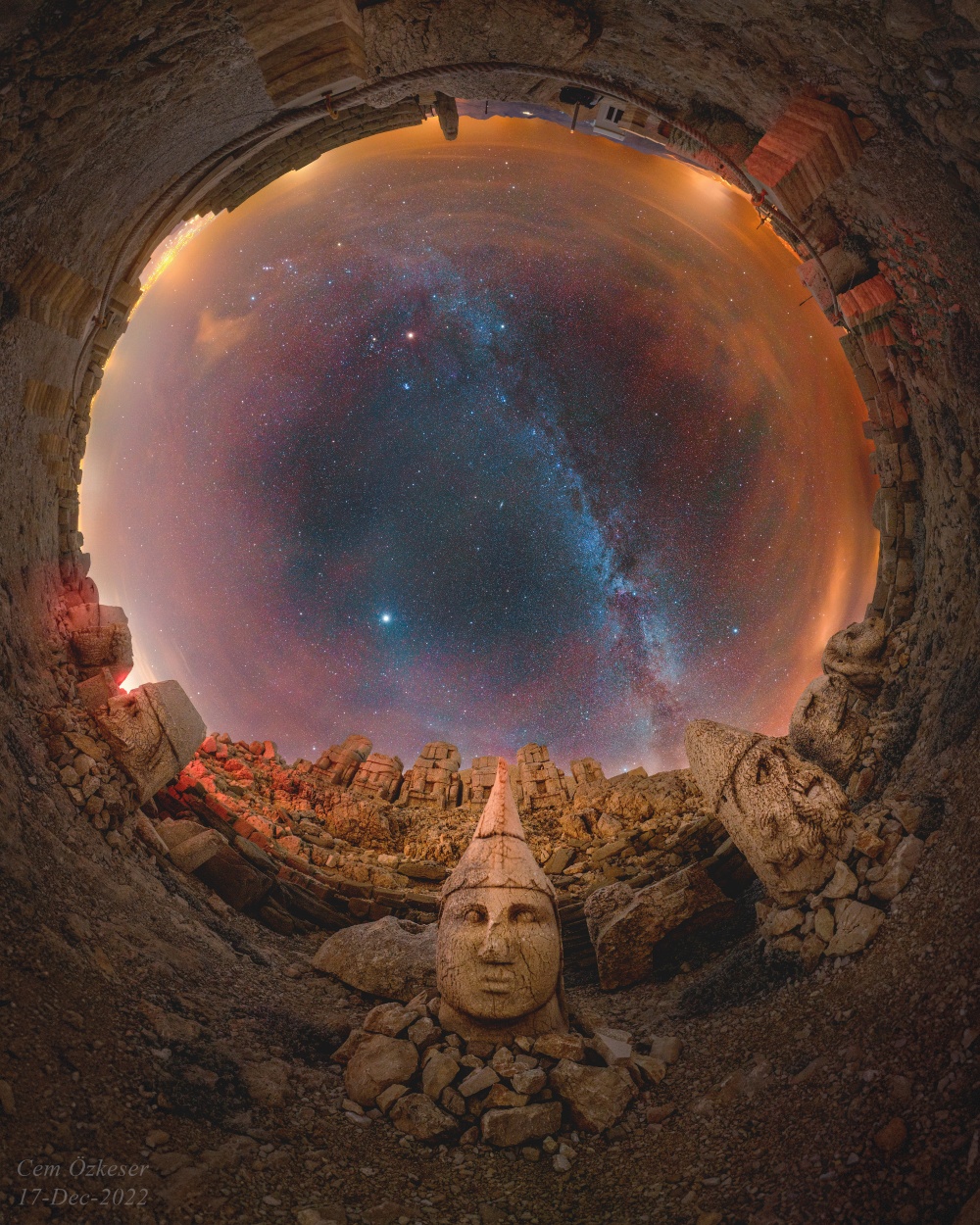
The Second-Prize TWO Winners
♦1/2 Photo Number:293 Lions' Den
Photographer: Lorenzo Ranieri Tenti
Country: Italy
Title of your Astrophoto: Lions' Den
Photo Date and place: Atacama Desert; 13th April 2023
Equipment used:Sony A7IV Camera; 35mm Sony GM lens; Fornax Mount LightTrack Star tracker; tripod
Data sheet:Panorama composed of stacked images taken at: 35mm, 30 secs, f2.8,iso6400, taken with astromodified camera, sky portion tracked, land portion untracked
Description:This image was taken on the plateau of the Atacama Desert, in a potentially dangerous area since it was a mountain lion reserve. I can't deny that spending the night there was a bit scary at times, however being able to photograph such a beauty was totally worth it. the arch of the MilkyWay in all its splendor rising above that pristine landscape.
Processing method:Basic lightroom adjustment,stacking with Sequator software, panorama stitching in Ptgui; editing in PixInsight; finalized in Photoshop
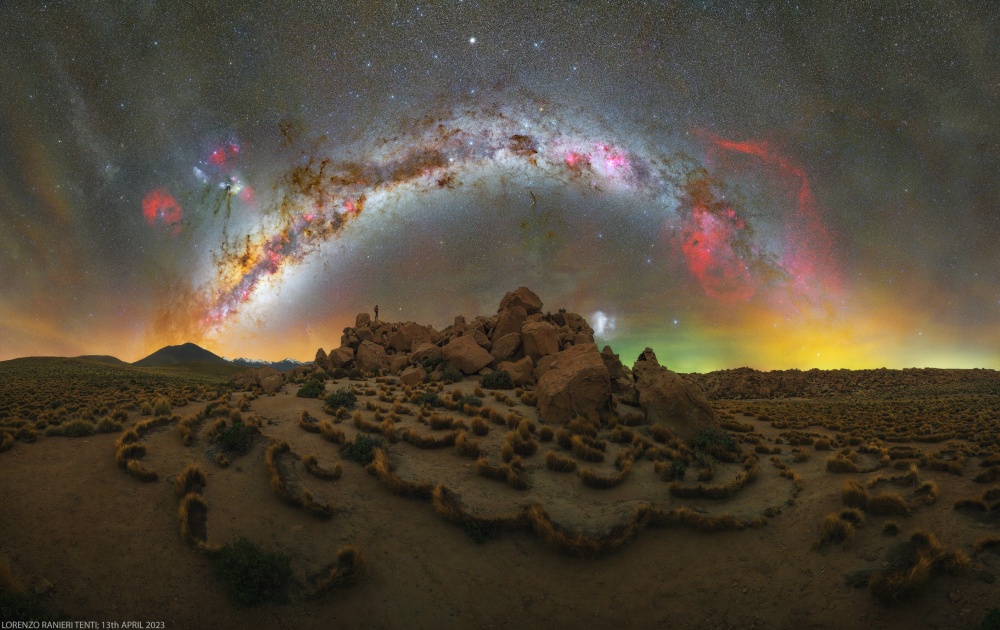
♦2/2 Photo Number:230 Aurora Milky Way
Photographer: Max Inwood
Country: New Zealand
Title of your Astrophoto: Aurora Milky Way
Description: Aurora Milky Way: Southern Milky Way arch during May 10th/11th Aurora storm. May 11 2024. Canon 6D, Sigma 28mm lens, iOptron SkyGuider Pro. Mount Cook National Park, New Zealand. Stitched in PTGui, processed in Photoshop.
This image was taken later into the night as the intensity of the southern lights began to fade off, and the Milky Way could finally shine through. This allowed me to capture a full sky panorama with both together. While I've caught the Milky Way and the Aurora in the same image, none have looked anything like this. The intensity of the aurora in all parts of the sky (including the SAR Arc in the north), was something pretty unique.
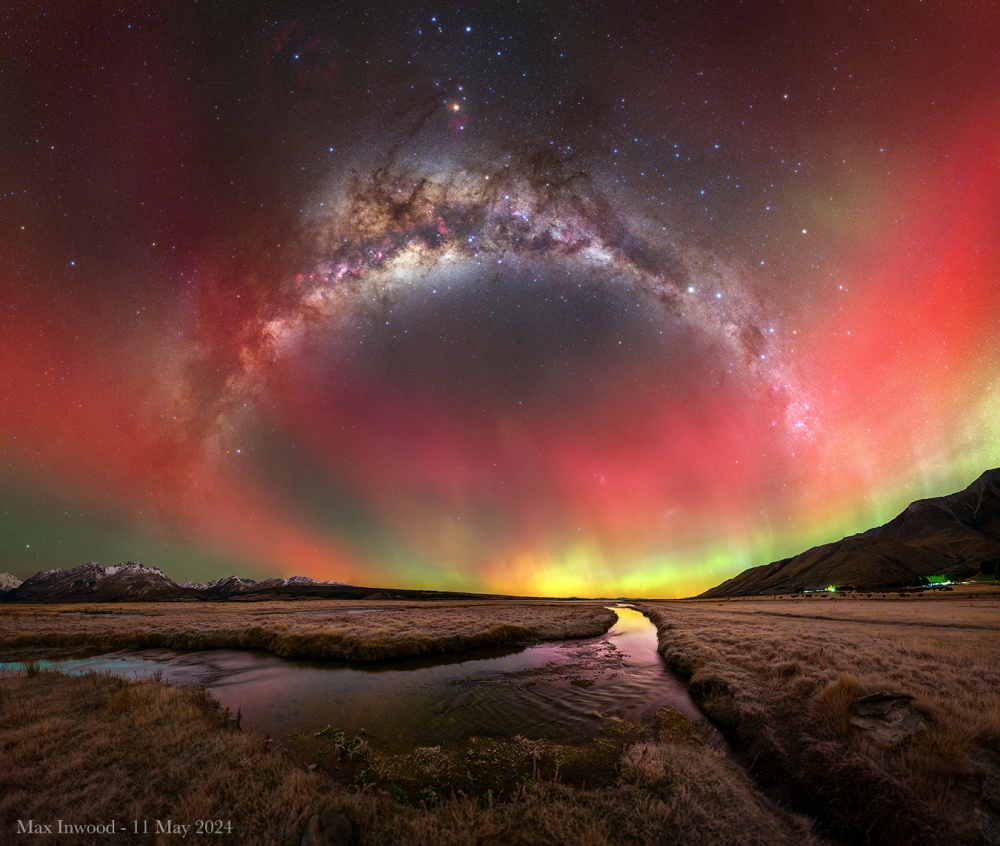
The Third-Prize THREE Winners
♦1/3 Photo Number:389 Spring Circumpolar
Photographer: Osvaldo Castillo
Country: Chile
Title of your Astrophoto: Spring Circumpolar
Photo Date and place: December 4, 2021 Equipment used:Nikon Z6 + Tokina 16 28 (@17mm)
Data sheet:Trails x309 25 sec, f/2,8, iso4000 // Foreground x1 25 sec, f/2,8, iso4000
Description:Startrails Circumpolar in the Southern Hemisphere visible even with the light pollution of the big city, Santiago de Chile. After a couple of kilometers of a trail, on a small plateau we found this lift chair, typical of the ski centers in the area. It is a perfect spot to align the moon, the sun or in this case this circumpolar star trails, visible even when we have a large city like Santiago de Chile and its light pollution in the background. Processing method:Image stacking, color editing and retouching in Photoshop, Final color in Lightroom
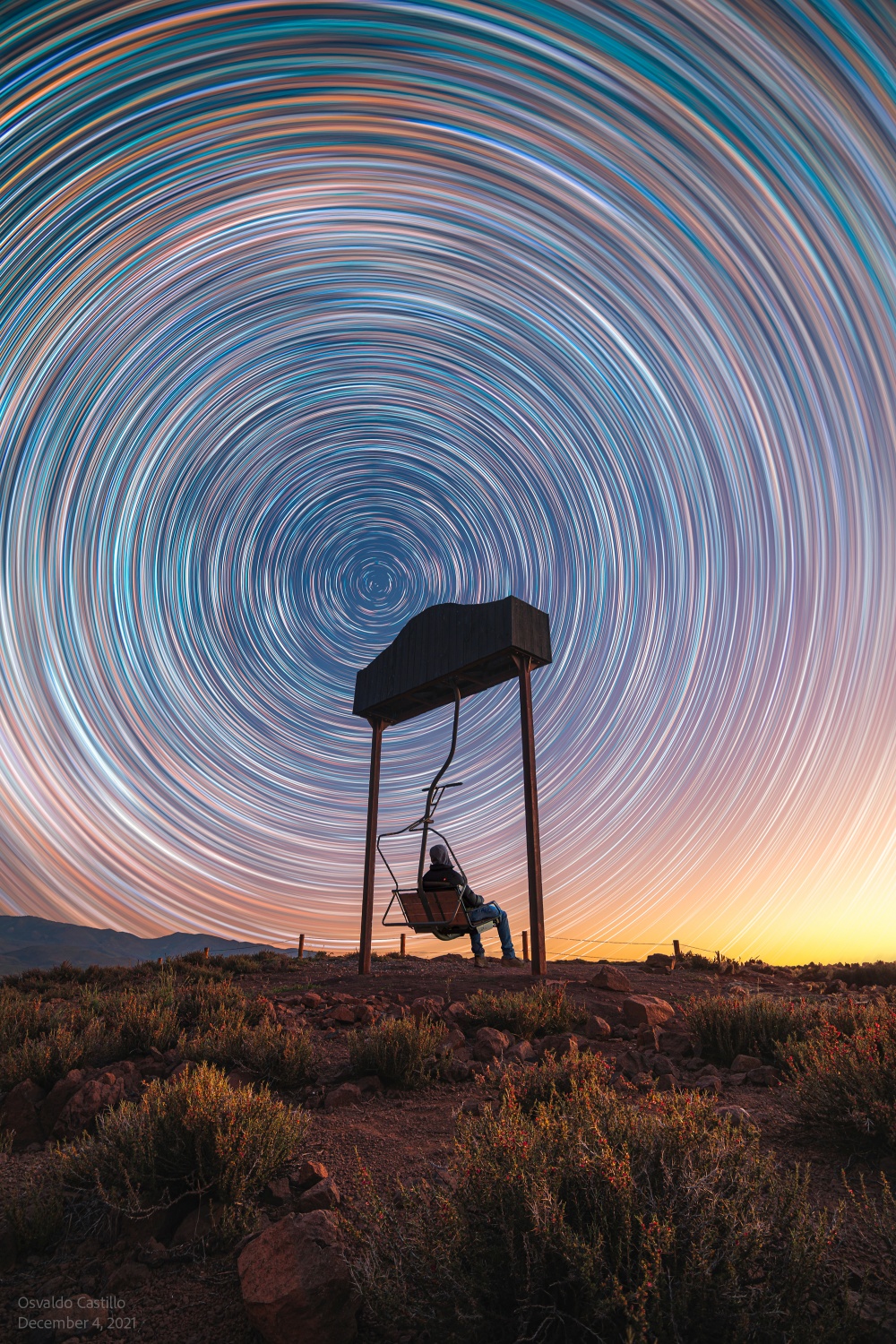
♦2/3 Photo Number:432 Moon Valley at Night
Photographer: Mauricio Salazar
Country: Uruguay
Photo Tittle and Target: Moon Valley at Night Photo
Date and place: 10 April 2024 - Moon Valley, San Pedro de Atacama, Chile
Equipment used:Sony A7RII halpha mod, Sony 20mm 1.8, Skywatcher Star Adventurer mini, halpha filter
Data sheet: Foreground: 30 seconds 1.8 iso 1600 each panel + 1 frame blended for silhouettes 8 seconds Sky: 30 seconds tracked 1.8 iso 3200 x 5 stack each panel + halpha filter for nebulas 60 seconds 1.8 iso 6400 x 5 stack
Description: Moon Valley (Valle de la Luna) near San Pedro de Atacama in Chile's Atacama Desert features surreal landscapes with rugged salt formations, towering sand dunes, and unique rock shapes, resembling the moon's surface. I spent 3 nights in this increible place searching for compositions to align with the milky way arch and luckily i found a rock formation full of salt that aligned perfectly in the center. I decided to climb to include myself in the photo to gave some sense of scale to this vast moon like place. Here I was able to witness the most incredible and clear sky to date.
Processing method:Sky panorama made in Astro Pixel Processor and foreground panorama made in Ptgui. Blending and editing was done in Photoshop.
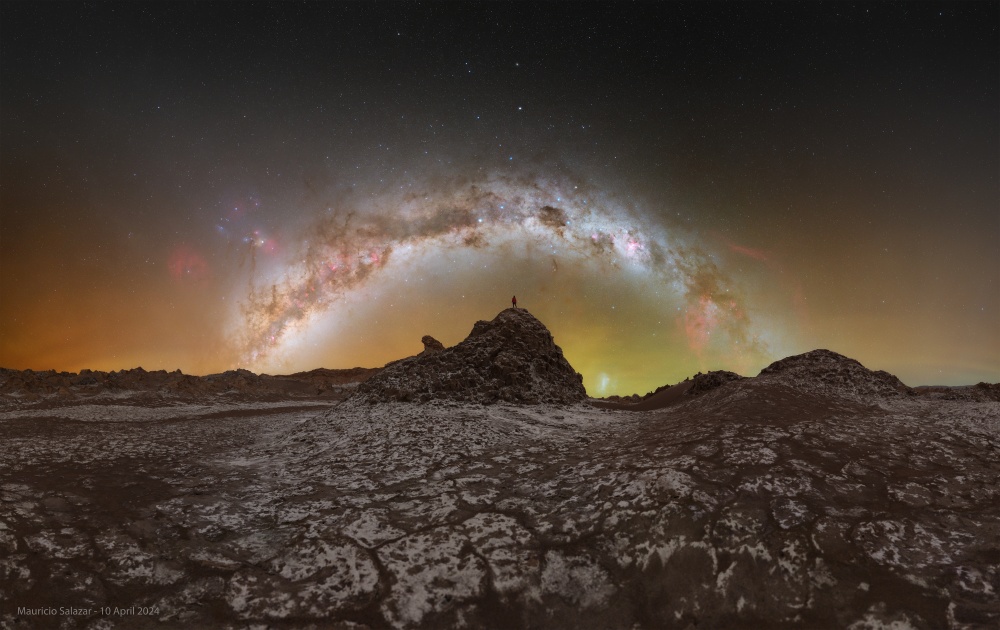
♦3/3 Photo Number:237 星辰之约
Photographer: 拂晓718
Country: China
Photo Tittle and Target/作品主题和目标:星辰之约
Photo Date and place /拍摄时间/地点:2024.3.9内蒙库布齐沙漠
Equipment used/拍摄器材:EOSR6+RF85 F1.2
Data sheet/拍摄参数:8Fmm F1.8 累计50min
Description/描述:广域巴纳德环星野
Processing method/处理方式: Pixinsight 对齐叠加,PS调色
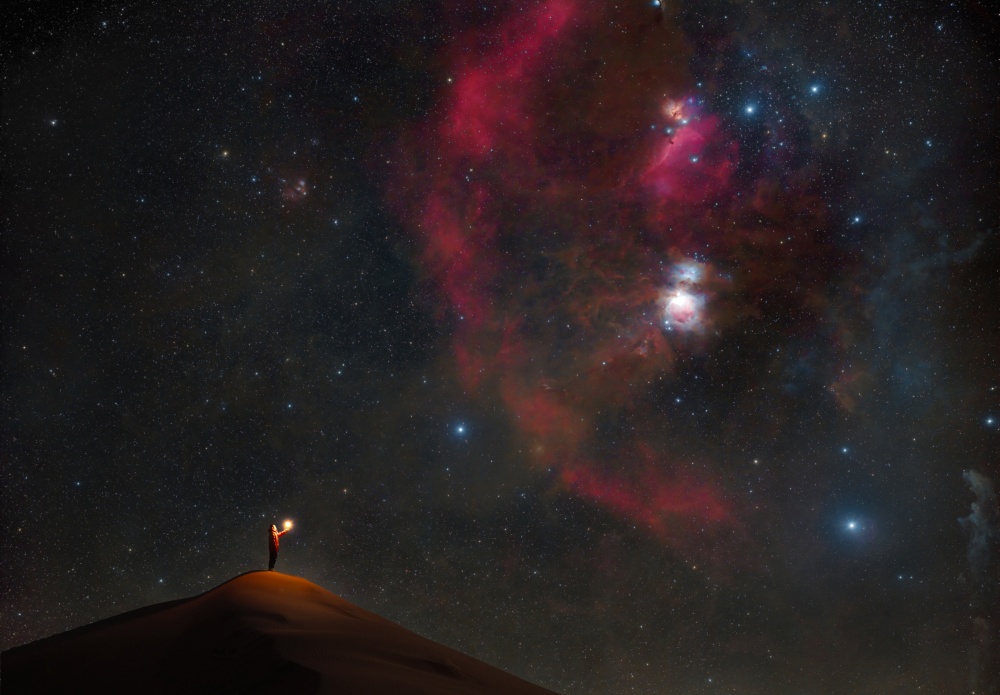
►Winners of the Special Celestial Category will be announced next.
| Special Celestial Categories | Winners Number | Prizes |
| The 1st Prize | One winner to be selected |
1>Cash prize of US$1,000 *1 2>Optolong Nikon Z series clip-in filter *1 3>Award certificate *1 |
| The 2nd Prize | One winner to be selected |
1>Cash prize of US$300 *1 2>Optolong Nikon Z series clip-in filter *1 3>Award certificate *1 |
| The 3rd Prize | One winner to be selected |
1>Cash prize of US$100 *1 2>Optolong Nikon Z series clip-in filter *1 3>Award certificate *1 |
The First-Prize ONE Winner
♦1/1 Photo Number:96 A night full of wishes,Perseid Meteor Shower
Photographer: Petr Horálek
Country: Czech Republic
Photo Tittle and Target: A night full of wishes,Perseid Meteor Shower
Equipment used for the capture: Canon Ra, Sigma Art 35mm (f2.0), Canon 6D, Samyang 12mm (f2.8) Shooting parameters: Ra - ISO 8000, and 76 single 10s exposures (panorama), 6D - ISO 8000 and 10000 (where the sky was darkest), always 30s exposures - meteors Date of capture: 9-14 August 2023
Location of capture: Poloniny, Slovakia Brief description of the work: The meteors of Perseids were captured from 9th to 14th August 2023 over Dark sky park Poloniny, Slovakia, with a pregnant woman who participated the observation nearby Kolonica observatory.
Post-processing techniques used: For the foreground, Canon Ra was used with Sigma Art 35mm, f2.0, ISO 8000, and 76 single 10s exposures were stitched to the final panorama (taken from a tripod, no tracking). Meteors were captured by timelapsing with two Canon 6D cameras on tripods, one with Saymang 12mm (f2.8) and one with Samyang 14mm (f2.8), with ISO 8000 and 10000 (where the sky was darkest), always 30s exposures. Meteors were then registered to the foreground panorama.
Interesting story related to the photograph: Anything you wish… may come true this night. They always say “make a wish” when a shooting star appears. Shooting stars, however, are not stars but meteors and it’s the glowing trail of a meteoroid or a piece of space debris that burns as soon as it enters the earth’s atmosphere. And it is this phenomenon that makes the shooting star very attractive, ideal, and considered as a lucky item for making a wish. Because a shooting star was a tangible symbol of the gods looking down at that moment, it was believed that a wish or request made upon seeing the star was more likely to be heard and granted. For many people, the best time for making their wishes comes every year around mid-August, when the icy dust of comet Swift-Tuttle enters the Earth’s atmosphere, bringing one of the most observed meteor showers ever–Perseids.
In this image, 223 Perseid meteors (some of them very bright with their persistent trains) captured during the 2023 Perseids peak over Poloniny Dark Sky Park bring chances to make a wish to a happy woman, who probably had wished one more wish a few months before that: To bring a new life on a small world called Earth.
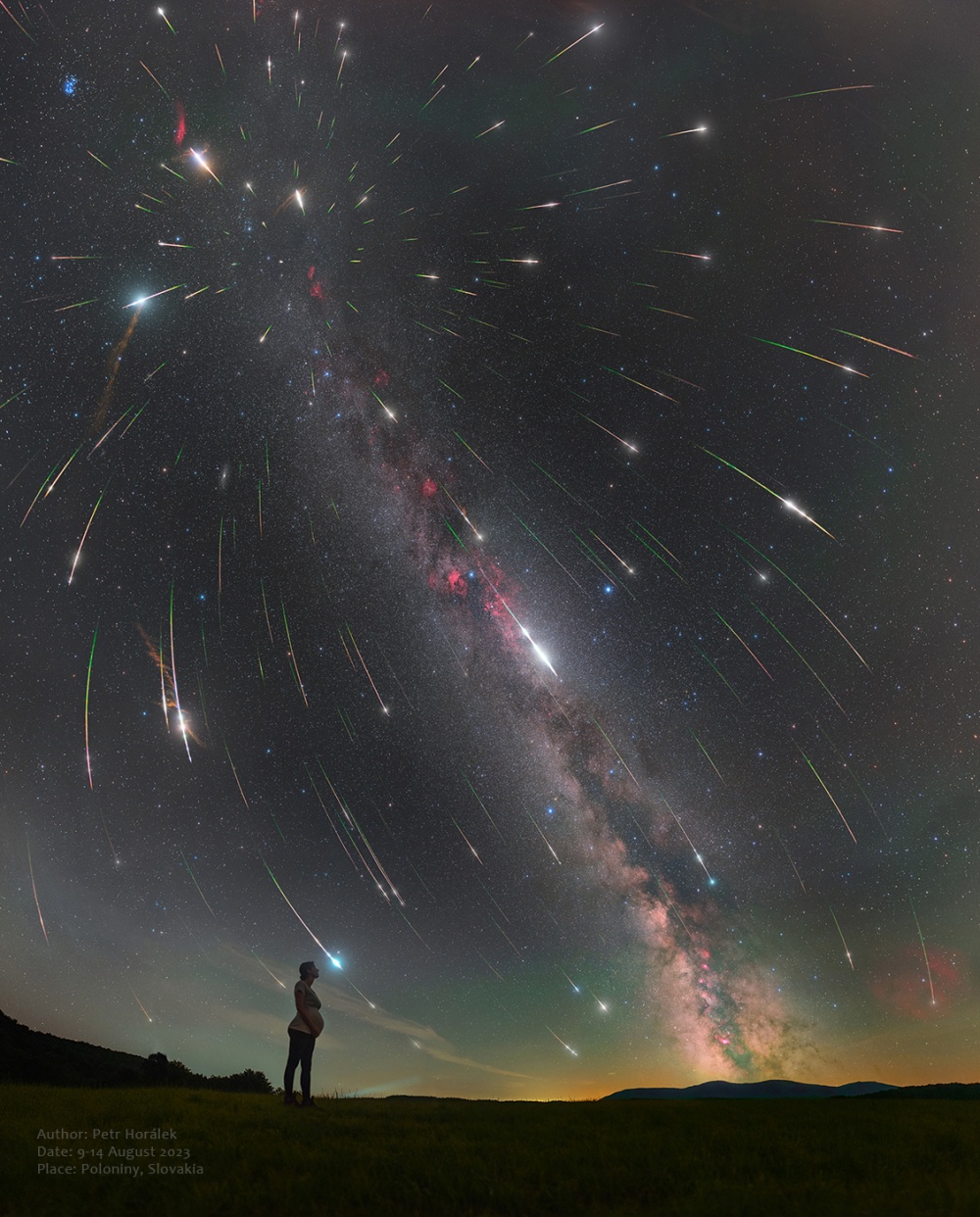
The Second-Prize ONE Winner
♦1/1 Photo Number:126 Crown of Light- Aurora Australis
Photographer: Kavan Chay
Country: New Zealand
Photo Tittle and Target: Crown of Light- Aurora Australis
Photo Date and place: 11th May 2024, Banks Peninsula
Equipment used: Nikon Z7a, Nikkor Z 14-24 f2.8S, Sky-Watcher Star Adventurer Pro 2i Data sheet:Sky: 6 frames x 2 rows (approximately), each shot at 16mm, f2.8, ISO800, 5 second exposures. Merged in PTGui and processed in Pixinsight. Foreground: 6 frames x 1 row, each shot at 16mm, f5.6, ISO3200, 30 second exposures. Merged in PTGui.
Description:The morning kicked off with a 3am start after about 3 hours of sleep, a failed photo mission and subsequent cry about it in freezing conditions. I'd sat down and faced south, and realised the massive display of colour I could see with the naked eye. I couldn't believe how lucky I was to see that display and how much of a difference it'd made to my day. I knew it was the start of something special, but this evening was beyond my expectations. I half expected the conditions to drop in some cruel twist of fate, but the amazing conditions held throughout the dayWith that, I drove multiple hours to this spot I knew was clear and managed to make my way out to these stacks that I've seen online previously, even though the route put me off last visit.As we arrived, the night was already kicking off with a bang, with the beams very clearly visible. A bit of wrestling around with focus, light and other photographers meant that I was in a suboptimal spot, but I managed to get lucky as there was plenty of room to move along and eventually get this view clear to myself.The aurora pulsed throughout the night, almost like it was alive. It was breathtaking to watch and really made all my past week of anxious thoughts quiet. It's incredible how nature can really help you with these things.Sadly, the cloud came to ruin the show, but I think at that point I was quite satisfied with how the past 24 hours had gone.
Processing method:Create sky and foreground panorama. Process sky in Pixinsight, blend with foreground panorama in Photoshop.
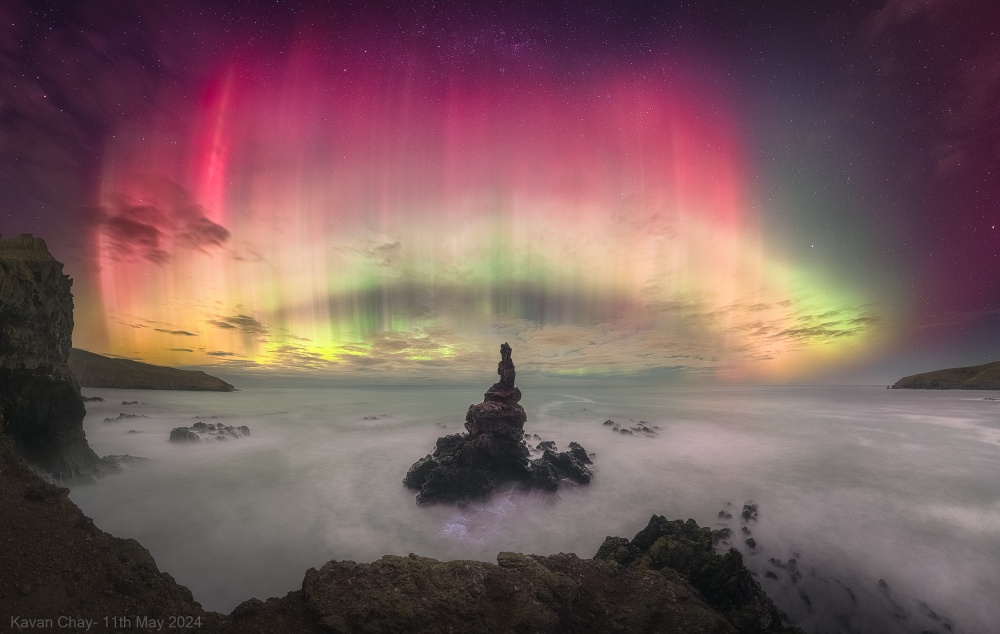
The Third-Prize ONE Winner
♦1/1 Photo Number:32 STOP ON THE COSMIC WAY
Photographer: CAYETANA ALEJANDRA SAIZ DE SIMÓN- ALTUNA (CAYETANA SAIZ)
Country: SPAIN
Photo Tittle and Target: STOP ON THE COSMIC WAY SUBJECT OF THE PHOTOGRAPH: 12P PONS BROOKS COMET, ANDROMEDA GALAXY, TRIANGULUM GALAXY, JUPITER AND MOON
DATE OF CAPTURE: MARCH 13, 2024 –LOCATION OF CAPTURE: SUESA (CANTABRIA) SPAIN –CATEGORY OF PARTICIPATION: CAT2. SPECIALCELESTIAL
EQUIPMENT USED FOR THE CAPTURE: CANON EOS 5D MARK IV + SIGMA 24-70 F2.8 + SIGMA ART 135 MM F1.8 + TRIPOD + ASTROMODIFIED CANON EOS 800D + EQUATORIAL MOUNT SKYWATCHER EQ35 PRO GOTO
SHOOTING PARAMETERS: FRAME 1. THE FOREGROUND, THE MOON AND JUPITER TAKEN DURING THE BLUE HOUR. 5D MARK IV + SIGMA 24-70 F2. 8,ISO 400 / 24MM / 9.6" / F 10 FRAME2. -12P/PONS-BROOKS: 126 X 10" STACKED (TOTAL 20'11'') CANON 800D ASTROMODIFIED + SIGMA ART 135MM F1.8 ISO 3200 / 135MM / 10" / F2 CALIBRATED WITH DARKS AND BIAS FRAME3.-ANDROMEDA GALAXY: TOTAL STACKING 2H30 CANON 800D ASTROMODIFIED + SIGMA ART 135MM F1.8 ISO 800 / 135MM / 151" / F3.2 CALIBRATED WITH DARKS AND BIAS –BRIEF DESCRIPTION OF THE WORK: JUPITER SHONE IN CONJUNCTION WITH THE MOON AND VERY CLOSE, IN THE CONSTELLATION OF ANDROMEDA, COMET 12P/PONS BROOKS CROSSED OUR SKIES AFTER 71 YEARS. IN THE IMAGE WE SEE THE ANDROMEDA GALAXY AND ALSO THE TRIANGLE GALAXY. –POST-PROCESSING TECHNIQUES USED: STACKING DEEP-SKY FRAMES WITH DEEP SKY STACKER, BASIC PROCESSING WITH SIRIL, BLENDING IMAGES WITH PHOTOSHOP AND STARS REDUCTION WITH ASTRONOMY TOOLS PLUGIN AND COLOR ADJUSTMENTS IN PHOTOSHOP.
INTERESTING STORY RELATED TO THE PHOTOGRAPH: THIS IMAGE IS THE RESULT OF THE COMPOSITION OF DIFFERENT PHOTOGRAPHS TAKEN THE SAME NIGHT (MARCH 13, 2024) AFTER SUNSET, JUPITER SHONE IN CONJUNCTION WITH THE MOON AND VERY CLOSE, IN THE CONSTELLATION OF ANDROMEDA, COMET 12P/PONS BROOKS CROSSED OUR SKIES AFTER 71 YEARS. IN THE IMAGE WE SEE THE ANDROMEDA GALAXY AND ALSO THE TRIANGULUM GALAXY. 12P/PONS-BROOKS IS A PERIODIC COMET DISCOVERED IN 1812 THAT IS NOW IN ITS FOURTH APPEARANCE. IT IS LARGE, THE COMETARY NUCLEUS IS ESTIMATED TO BE APPROXIMATELY 35 KM. IT HAS AN ORBITAL PERIOD OF 70 YEARS, SO ACCORDING TO THE CLASSICAL CLASSIFICATION, IT IS A HALLEY-TYPE COMET. THE IMAGE IS AN ASTRO-NIGHTSCAPE AND A SELF-PORTRAIT TOO.
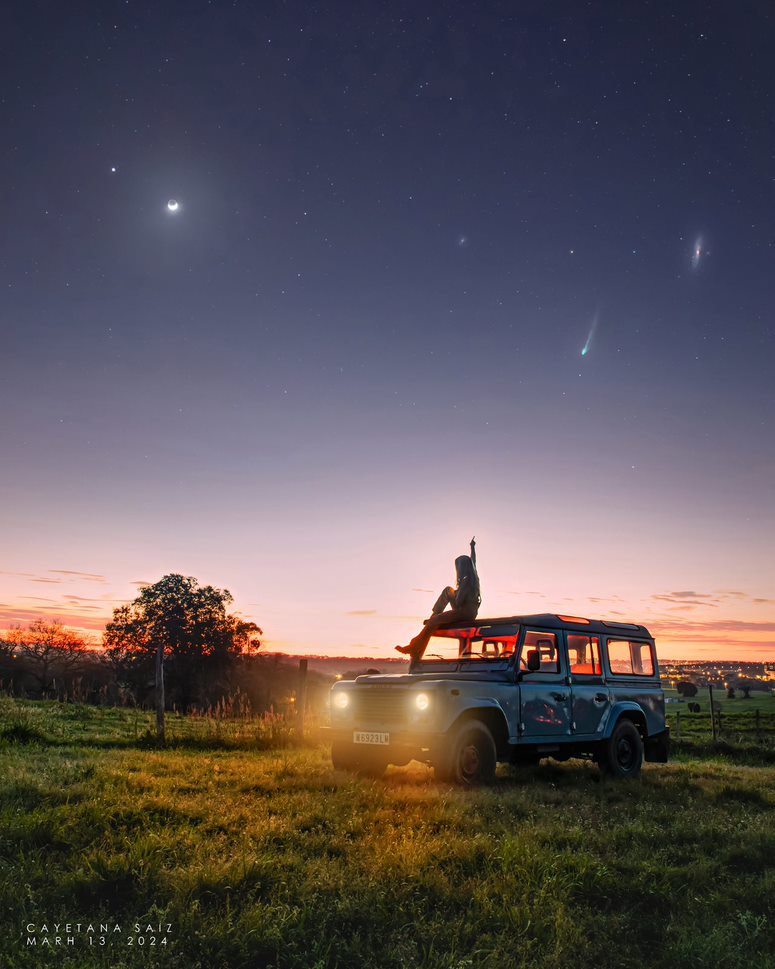
Prizes will be delivered to winners by post soon.
LIKE AND FOLLOW US on Facebook, Twitter, Instagram , and YouTube, medias. Thanks for your attention.








